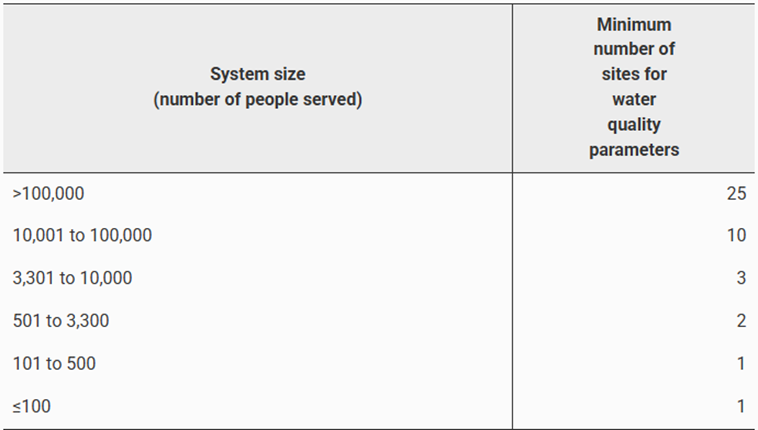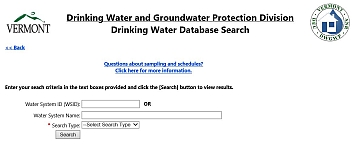Last Updated: May 13, 2025
A Distribution System and Site Assessment must be completed when one or more lead results from an individual tap sampling location exceeds the 0.010 mg/L (10ppb) action level. The assessment steps and associated due dates are outlined below.
*DISCLAIMER: THE LCRI IS CURRENTLY UNDER A LEGAL HOLD ON IMPLEMENTATION. THIS WEBSITE WILL BE UPDATED PERIODICALLY AS INFORMATION BECOMES AVAILABLE.*
Step 1: Corrosion Control Treatment Assessment
If a water system uses corrosion control treatment, the water system must collect a water sample at a water quality parameter location on the same size water main and same pressure zone, within half a mile of the original lead sample location. The sample must be analyzed for:
- pH
- Alkalinity
- Orthophosphate (if in use)
If the Water System does not already have a water quality parameter location within their lead and copper sampling plan that matches the description above, the water system must add new site(s) until the system has twice the minimum number of sites listed in Table 1 {141.87 (b)(1)(i)}

Samples must be collected within five (5) days of receiving sample results above the 10ppb threshold.
If a water system is unable to collect a follow-up sample, it must provide documentation to the State explaining why it was unable to collect this follow-up sample.
Step 2: Site assessment
Water systems must collect a follow-up, lead only sample at the same sample location that exceeded the 10ppb threshold during routine monitoring. These samples must be reported to the State but are not used in compliance calculations.
IMPORTANT: Ensure the samples are labeled as “Special Purpose” in the sampling site name of the follow-up sample, so the results are easily differentiated in the database and are not included in the compliance calculations.
Sample(s) must be collected within thirty (30) days of receiving sample results above the 10ppb threshold.
If a water system is unable to collect a follow-up sample, it must provide documentation to the State explaining why it was unable to collect this follow-up sample.
Step 3: Evaluation and treatment recommendation
The Water System must evaluate the results of Step 1 & Step 2 and submit a recommendation to the State. The recommendation may be corrosion control treatment modification or other mitigation protocol(s). It is possible that corrosion control treatment modification may not be necessary to address every exceedance. Other distribution system actions may include flushing to reduce water age.
Water systems must note the cause of the elevated lead level, if known from the site assessment, in their recommendation to the State as site-specific issues can be an important factor in why the system is not recommending any adjustment of corrosion control treatment or other distribution system actions.
Systems in the process of optimizing or re-optimizing optimal corrosion control treatment do not need to submit a treatment recommendation for distribution system and site assessment.
The recommendation form will be available via ANR Online soon.
The recommendation is due within six (6) months after the end of the tap sampling period where the exceedance occurred in.
Step 4: State review of treatment recommendation
The State must review the treatment recommendation. The State must respond within six (6) months of completing Step 3.
Step 5a: Modifications to water system corrosion control
If the State approved treatment recommendation requires modifications of the water system’s corrosion control, the water system must complete these activities within twelve (12) months of being notified by the State.
Step 5b: Distribution System Adjustments
If the State approved recommendation includes distribution systems adjustments, the adjustments should be made as soon as practical.
Step 6: Follow-up Lead Sampling
Water systems that adjust their corrosion control must complete follow-up sampling at the sampling site or sites that originally exceeded 0.010 mg/L (10 ppb) to ensure the corrosion control adjustments were successful.
IMPORTANT: Ensure the samples are labeled as “Special Purpose” in the sampling site name of the follow-up sample, so the results are easily differentiated in the database and are not included in the compliance calculations.
The sample(s) must be collected within twelve (12) months after completing Step 5.
Step 7: Return to Standard Monitoring for Lead and Copper
Once modifications of the corrosion control treatment system are made, the water system must return to standard monitoring.
Step 8: Re-designation of Optimized Water Quality Parameters
The State must review the water system's modification of corrosion control treatment and designate optimal water quality parameters in accordance with the rule within six (6) months of receiving follow-up sampling results (Step 7).
Step 9: Operate in compliance
A Distribution System and Site Assessment flow chart is available.


